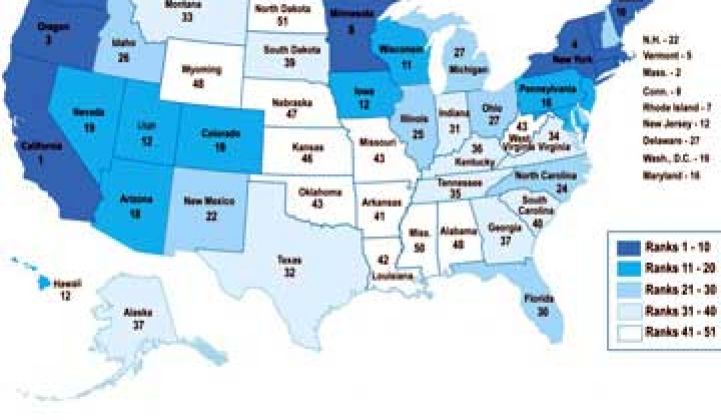Mississippi does not garner a lot of praise when it comes to national rankings. Not only has it held steady as the most obese state in the nation for the past few years, it also sits at the bottom of the most recent energy efficiency scorecard (along with North Dakota) produced by the American Council for an Energy-Efficient Economy.
The Southwest, conversely, stands out as the most improved in energy efficiency in the U.S., according to the new report from the ACEE. Utah, Arizona, New Mexico and Alaska all saw big jumps in their positioning, with Utah catapulting to 12 from a ranking of 23 just one year ago.
The largest portion of points came from rankings on utility and public benefit programs and policies, which could add up to 20 of the 50 total points. The other five categories included transportation policies, building energy codes, combined heat and power, state government initiatives and appliance and equipment efficiency standards. Although there were some silver linings, many of the efforts by individual states are still range from less than stellar to far behind.
Here are some other findings from the report:
- Many states are raiding their energy efficiency coffers to pay for budget shortfalls. New York has diverted about $90 million from RGGI proceeds to the general budget.
- Although there was a lot of mobility in the rankings, California still held on to the top spot, with Massachusetts not far behind.
- Only nine states had energy efficiency budgets that were more than 2 percent of utility revenues. Vermont was far in front at 4.4 percent, or $30 million, while California was second, but budgeted nearly $1 billion.
- Vermont also led in incremental electricity savings by state with 147,549 MWh, or 2.59 percent saved from 2008 to 2009. No other state even hit 2 percent, although Hawaii was close.
- Renewable Portfolio Standards have been adopted as a mandatory target in 29 states.
- Vermont plans to cut 105 MW of peak demand by the end of 2011.
- Arizona mandated that all investor-owned utilities and some electric coops cut 22 percent of energy use by 2020.
- About 10 states have some sort of decoupling incentive in place for utilities, with another 10 that have plans authorized but not implemented yet.
- Only 11 states spend $50 or more per capita on transit.
- There are now 11 states, down from 17 in 2009, which still have zero or no verifiable rates of compliance for building energy codes.
- Even though the number of states with no verifiable rates of compliance has shrunk, there are 12 states that do not even have statewide mandatory energy codes for residential or commercial buildings.
- Maryland is emerging as a leader in energy efficiency financial incentive programs, offering loans to residential, institutional, agricultural, small business and industrial sectors.
- Only five states are leading by example in implementing significant energy efficiency policy for their own facilities and fleets. Those states are California (no surprises here), Colorado, Delaware, New Hampshire, Hawaii and Utah. Hawaii, for example, dropped its electric consumption 5.8 percent from 2008 and saved an estimated $10 million.
- No wonder only one-third of appliances on the market even meet ENERGY STAR requirements. Currently, only 14 states have standards that surpass the feds for appliances.
The lessons from some of the movers and shakers in this year’s report indicate that savings only come when hard targets are set. Arizona and Utah set goals for energy efficiency, while New Mexico adopted more stringent building energy codes. Legislation continues to reign as the best way to move energy efficiency forward.



